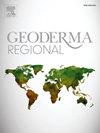Transformation of Chernozem by increasing land use intensity in suburban Hajdúság, Eastern Hungary
IF 3.3
2区 农林科学
Q2 SOIL SCIENCE
引用次数: 0
Abstract
Chernozem under different agricultural land use were compared in a suburban area: three on cropland with different land use histories; one in an area of complex cultivation; one fallow; and one under grassland, considered to be in close to natural state, as a control. Soil profiles at each site were described and classified, and chemical characteristics analyzed in detail. Topsoil (0-40 cm) bulk density (BD), total organic carbon (TOC), total nitrogen (TN), ammonium lactate-extractable P, K, Ca and Mg were measured, and microbiological communities were characterized by phospholipid-fatty acid (PLFA) markers. We found significantly increased BD but decreased TOC and TN in the cultivated sites compared to the control. Values of ammonium lactate-extractable P (P-AL) were higher at the natural site, but Ca-AL, Mg-AL and K-AL content of the cultivated and mineral-fertilized agricultural sites were higher than or equal to the grassland site. Total microbiological activity correlates significantly positively with TOC and TN and negatively with the BD. Sites with perennial vegetation cover and higher biodiversity showed greater microbiological activity and, in case of the arbuscular mycorrhizal fungi, actinobacteria and anaerobe bacteria, the differences are significant. Despite the nutrient depletion and lesser microbiological activity, cropland sites preserved their taxonomic status as Chernozem. Sites that have undergone more extreme human impacts before the recent land use had lost their diagnostic features (aggregation, color, secondary carbonate accumulation) and now key out as Kastanozem, Phaeozem or Regosol.
通过增加土地利用强度在匈牙利东部Hajdúság郊区改造Chernozem
对城郊不同土地利用方式下的黑钙土进行了比较:3种土地利用方式下的黑钙土;栽培者:在复杂栽培地区的人;一个休闲;另一个在草地下,被认为是接近自然状态的,作为对照。对每个站点的土壤剖面进行了描述和分类,并对其化学特征进行了详细分析。测定表层土壤(0 ~ 40 cm)容重(BD)、总有机碳(TOC)、总氮(TN)、乳酸铵-可萃取的P、K、Ca、Mg,并用磷脂-脂肪酸(PLFA)标记对微生物群落进行表征。我们发现,与对照相比,栽培地的生物量显著增加,而TOC和TN则显著降低。自然样地乳酸铵可萃取磷(P- al)含量较高,而栽培和矿肥农业样地的Ca-AL、Mg-AL和K-AL含量均高于或等于草地样地。总微生物活性与TOC和TN呈显著正相关,与BD呈显著负相关。多年生植被覆盖和生物多样性较高的样地微生物活性较高,其中丛枝菌根真菌、放线菌和厌氧菌的差异显著。尽管养分消耗和微生物活性较低,农田遗址仍保持了其黑钙土的分类地位。在最近的土地利用之前经历了更极端的人类影响的地点已经失去了它们的诊断特征(聚集、颜色、次生碳酸盐堆积),现在主要是Kastanozem、Phaeozem或Regosol。
本文章由计算机程序翻译,如有差异,请以英文原文为准。
求助全文
约1分钟内获得全文
求助全文
来源期刊

Geoderma Regional
Agricultural and Biological Sciences-Soil Science
CiteScore
6.10
自引率
7.30%
发文量
122
审稿时长
76 days
期刊介绍:
Global issues require studies and solutions on national and regional levels. Geoderma Regional focuses on studies that increase understanding and advance our scientific knowledge of soils in all regions of the world. The journal embraces every aspect of soil science and welcomes reviews of regional progress.
 求助内容:
求助内容: 应助结果提醒方式:
应助结果提醒方式:


